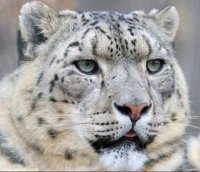 A photo of the disappearing “red Book’ snow leopard, taken with the use of photo-traps, was made in the remote high mountain district Mongun-Taiga in Tuva. The first identification photo of an irbis was taken in the Russian part of the border-spanning Tsagan-Shibetu ridge. This was announced today by the press-secretary of the Altai-Sayan project of WWF in RF, Tatiana Ivanitskaya. A photo of the disappearing “red Book’ snow leopard, taken with the use of photo-traps, was made in the remote high mountain district Mongun-Taiga in Tuva. The first identification photo of an irbis was taken in the Russian part of the border-spanning Tsagan-Shibetu ridge. This was announced today by the press-secretary of the Altai-Sayan project of WWF in RF, Tatiana Ivanitskaya.
In her words, this is the first time that the photo-trap method was used on Tuvan territory. It became possible in the framework of the program of the irbis study on the territory of RF with the support of the Russian government. The main goal of this expedition is to incorporate the newest scientific methods for the study of the condition of different groupings of irbis on the RF territory, such as use of photo-traps, analysis of genetic material, and radio monitoring.
These measures will allow to determine the approximate numbers of the snow leopard on the Tsagan-Shibetu ridge, to study the territorial areas of individual irbises, and to determine the sex and age composition of groupings, idiosyncrasies of behavior, and to monitor the further development of their condition.
More that 40 photo-traps have been set up in the area. The first photo suitable for identification of an individual was made almost a month after the start of the work of the expedition. Mongun-Taiga district is one of key areas of snow leopard habitat in Tuva. This is the part of the “Uvsu-nur depression” nature preserve where it is planned to set up a part of the preserve for protection of irbis and argali.
Illegal hunting of irbis for his fur subsatntially decimated their numbers. The skin of this animal can bring up to 60 thousand dollars on the Asian black markets. Ecologists believe that the survival of snow leopard in Tuva is threatened: herdsmen shoot the predators to protect their livestock from their depredations, and poachers kill them for their skins and carry away their cubs to sell. According to approximate calculations, at the height of 4000 meters in the western regions of the republic there live approximately 30-40 snow leopards.
|
